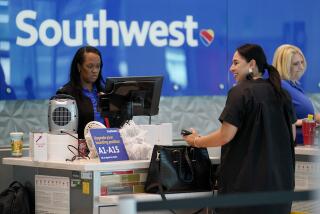The New Europe Gives a Boost to Vacation Travel : Airlines: Changes in Eastern Europe and the growing popularity of more exotic destinations spur ticket sales by international carriers.
- Share via
Expansion of U.S. air carrier service to international destinations coupled with the historic changes sweeping across East Europe are spurring travelers to go overseas in droves, say San Diego travel agents, who are experiencing a busy summer.
But transatlantic flights aren’t the only tours giving international travel a boost, local travel agents and industry observers add.
Growing popularity of “exotic” destinations in the South Pacific, such as Australia, New Zealand and the Fiji Islands, have helped U.S. airlines post double-digit growth in revenue passenger miles the last three years. The standard measuring stick for the airline industry, one revenue passenger mile equals one paying passenger flown one mile.
Revenue passenger miles have been growing at an even healthier clip so far this year, industry observers say.
During the first five months of 1990, U.S. carriers registered 42.7 billion revenue passenger miles, up 18.5% over the 36.1 billion revenue passenger miles recorded during the same period in 1989, according to the Air Transport Assn., the Washington-based industry group.
The number of passengers boarding international flights also increased: during the first five months of 1990, U.S. airlines carried 15.6 million passengers, up 14% over the 13.7 million travelers who boarded overseas flights during the same period last year.
Such growth almost guarantees the fourth, consecutive year that international travel will post a record revenue passenger miles figure, said Lee Howard, chief executive officer of Airline Economics, a Washington-based airline consulting firm and publisher of industry publications.
“A globalization movement is afoot,” Howard said. “The world is getting smaller at a geometric rate. There is more cohesiveness among countries, there are more business connections among countries. That has created a demand for international service and, as more international service is offered, more people travel overseas. We’re in a growth cycle.”
Since 1987, international revenue passenger miles have increased at an average annual rate of 10%, Howard said.
“I wouldn’t be surprised if this is a record growth year,” Howard said. “There’s no question that we’re going to reach a record level (of revenue passenger miles).”
International travel is making a strong comeback after suffering major setbacks suffered in 1986: the Chernobyl nuclear accident and a spurt of terrorist activities persuaded travelers to keep their feet on the ground.
“With the terrorist activities that took place in 1986 behind us, we’ve noticed that people are ready to go back out there,” said Michelle Goggin, leisure travel counselor at Balboa Travel in San Diego.
“Not only are they traveling to traditional European destinations in greater numbers, they’re going to areas, what used to be the less popular areas, in Eastern Europe,” Goggin said. “With the Berlin Wall going down, with more countries striving toward westernization . . . with glasnost more people are interested in going to the Soviet Union.”
Although Goggin could not provide specific figures, she said trips to Eastern Europe this summer have “at least doubled, if not tripled” over last year.
Local travel agencies are booking many flights to traditional European destinations such as Austria and Switzerland, but Hana Huvar, a travel agent-trainee at Firstworld Travel of El Cajon, said Czechoslovakia and Poland are gaining attention, too. Huvar should know: in May, she traveled back to her hometown of Zlin, Czechoslovakia, for the first time since her native country instituted a democratic form of government.
“There are many people who left Eastern Europe and came to live in San Diego,” Huvar said. “Now a lot of them are going back to see what’s happening in their homeland.”
But other regions of the world are attracting the attention of globe-trotters, too, travel agents say. Mexico continues to be a strong lure for San Diegans. In fact, Aero California, a Mexican airline, will start direct flights from San Diego to Cabo San Lucas at the tip of Baja California on Wednesday.
The America’s Cup and aggressive advertising by Australian tourism officials in recent years have boosted the popularity of trips “down under.”
“People want to go further than just Hawaii,” Goggin said. “They’re heading for Australia, New Zealand, Fiji, Tahiti.” A round trip fare to Sydney costs about $1,000.
But Goggin is well aware that the outbreak of turmoil in foreign lands can bring an abrupt halt to growth patterns.
Trips to China and excursions to Hong Kong or other nearby cities were gaining popularity until the June 1989 civil disturbances. “Those trips have significantly declined,” said Goggin.
Expansion of service and the addition of destinations have also played a major role in boosting international traffic volume.
“In addition to new routes, you’re seeing more airports used for international flights,” said David Swierenga, ATA’s assistant vice president. “Traditionally, most international flights were from New York, Los Angeles and Miami, but, in recent years, you’re seeing international service out of places like Pittsburgh and Dallas.”
American Airlines, which posted a 14% June-to-June gain in revenue passenger miles, is one such carrier that is trying to establish a presence in the international market, said Al Becker, a company spokesman.
In February, American Airlines inaugurated service to Sydney, Australia, and Auckland, New Zealand. Then in May, American introduced three non-stop routes from Chicago to Glasgow, Scotland, to Munich and to Dusseldorf. A non-stop flight from Miami to London just began this month.
“It’s just a reflection of the demand for international travel,” Becker said.
Pan Am, which services 68 cities in Europe, Latin America, the Caribbean, Asia, Africa and the Middle East, has also benefited from the crumbling of the Iron Curtain, said Elizabeth Hlinko, a company spokeswoman. Pan Am flies to 11 cities in Eastern Europe and the Soviet Union, including non-stop flights from New York to Budapest, Moscow and Warsaw.
During the first six months of 1990, Pan Am registered 14.7 billion revenue passenger miles, up 11.4% over 13.2 billion revenue passenger miles recorded during the same period last year.
“With Eastern Europe becoming such a hot spot, that has certainly helped our figures,” Hlinko said.
More to Read
Inside the business of entertainment
The Wide Shot brings you news, analysis and insights on everything from streaming wars to production — and what it all means for the future.
You may occasionally receive promotional content from the Los Angeles Times.










